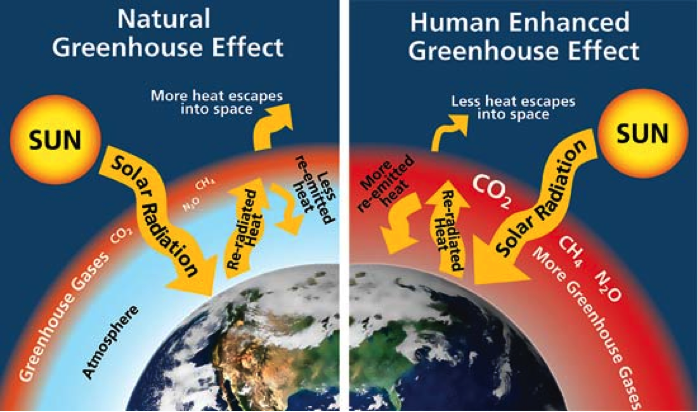1. Mammoth Cave National Park in Kentucky is in close proximity to the coal-fired electric utility plants in Ohio Valley. Noting this, the National Parks Conservation Association (NPCA) reported that this national park had the poorest visibility of any in the country.
a) What is the connection between coal-fired plants and poor visibility.
b) The NPCA reported “the average rainfall in Mammoth Cave National Park is 10 times more acidic than natural.” From this information and that in your text, estimate the pH of rainfall in the park.
Answer:
a) Coal-fire plants produce sulphur dioxide creating sulfate particles which is responsible for the poor visibility.
b) Normal rain pH is about 5-6 pH. If the average rainfall in Mammoth Cave National Park is 10 times more acidic, this means that the pH of the rainfall is 4-5 pH.
2.Here are examples of what an individual might do to reduce acid rain. For each, explain the connection to producing acid rain.
a) Hang your laundry to dry it.
b) Walk, bike, or take public transportation to work.
c) Avoid running dishwashers and washing machines with small loads.
d) Add additional insulation on hot water heaters and pipes.
e) Buy locally grown produce and locally produced food.
Answer:
a) Water evaporates from the clothes which in turn produces water vapour. H2O combines with SOx and NOx in the air to produce H2SO4 and HNO3 (Acid rain).
b) Public transportation produces NOx from the exhaust which dissolves with H2O in the air to form HNO3 which in turn contribute to the possibility of acid rain.
c) The amount of electricity needed to run dishwashers and washing machines does not change with the amount of load. As such, more fuel is required to run the machines and in turn produces compounds which contribute to the formation of acid rain.
d) With additional insulation on hot water heaters and pipes, this increases the efficiency of the heat systems as there will be lesser heat loss to the surroundings. As such, lesser fuel is required to compensate for the negligible heat loss.
e) Buying local food, this amounts to lesser import by plane or ships. This results in less fuel burnt to run the planes and ships and thus, reducing the chance of acid rain formation.
3. a). Give names and chemical formulas for five acids and five bases.
b). Name three observable properties generally associated with acids and bases.
Answer:
a)
|
Acid |
Base |
| Hydrochloric Acid (HCl) | Ammonia (NH3) |
| Sulphuric Acid (H2SO4) | Sodium Hydroxide (NaOH) |
| Nitric Acid (HNO3) | Magnesium Hydroxide (Mg(OH)2) |
| Phosphorus Acid (H2PO4) | Ammonium Hydroxide (NH4OH) |
| Sulphurous Acid (H2SO3) |
Calcium Hydroxide (Ca(OH)2) |
b)
1. Acids turn blue litmus paper red.
2. Bases turn red litmus paper blue.
3. When acid reacts with an active metal, effervescence is observed and gas evolved will extinguish a lighted splint with a ‘pop’ sound.
4. Bases feel slippery and soapy.
4. The concerns of acid rain vary across the globe. Many countries in North America and Europe have websites dealing with acid rain. Either search to locate one (“Canada, acid rain”) or use these links to websites in Canada, the UK, or Europe. What are the issues in Singapore? Does the acid deposition originate outside or inside the Singapore’s borders?
Answer:
In the course of pursuit for industrialization to reach a level of development, many Asian nations emphasized on economic development, coupled with the high rate of population growth stemming from an already large population base, guarantees that SO2 and NOx emissions will increase significantly. This is because technology is emerging at a rapid rate, cutting the need for manpower and in turn, increasing the usage of machines.
As atmospheric contaminant are able to be transported over a long distance before it is being deposited, atmospheric pollution and acidification in Asia is a cause of concern to the Singapore Environment.

 Source: http://www.conserve-energy-future.com/wp-content/uploads/2013/04/Deforestation_ForestDamage.jpg
Source: http://www.conserve-energy-future.com/wp-content/uploads/2013/04/Deforestation_ForestDamage.jpg